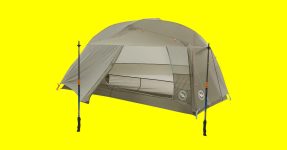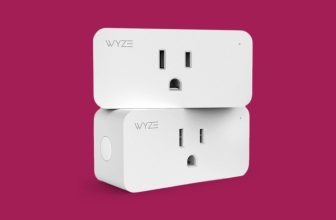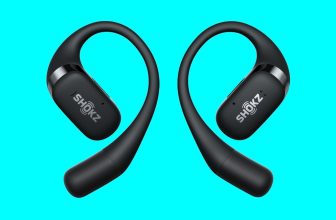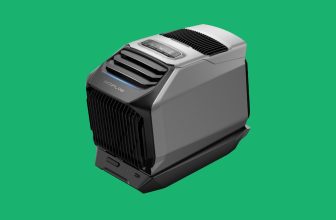
Big Agnes Copper Spur UL1 Review: Small Tent, Big Winner
Have you met Big Agnes? Maybe you’ve seen it perched excessive on a shelf at REI or lounging at a neighborhood campground. Not ringing a bell? It might be that you simply’re not sufficient of an ultralight tenting nerd to have been launched.
The Steamboat Springs, Colorado-based firm makes a number of the most bleeding-edge tents within the outside business, however solely on the higher finish of the market, aimed toward hikers and backpackers who need the lightest, highest-performing tents and have the money to pay for them. The Copper Spur collection was up to date in 2020 to incorporate a vestibule that may be propped open with a pair of trekking poles like a porch awning. The newest mannequin comes with lighter-weight material and a brand new tent buckle system for the guylines.
I gave it a multiweek take a look at in California’s Death Valley and Arizona’s Grand Canyon, subjecting it to temperatures that assorted from near-freezing to over 90 levels Fahrenheit (32 levels Celsius) and campsites from damp mountains and thicketed riverbanks to roasting desert flooring. Keep studying to seek out out why, even with a few important drawbacks, I like to recommend the Copper Spur UL1 as the most effective ultralight backpacking tent in the marketplace. If you need the most effective, generally it’s important to pay for it.
Weighting Around
With a path weight of two kilos, 2 ounces (about 960 grams), it’s on the reducing fringe of ultra-lightweight tents. The Copper Spur is a totally freestanding tent, just like the rival MSR Hubba Hubba NX, which implies it doesn’t depend on guyline tie-outs—traces you connect to the bottom or different objects—for core structural integrity. Ties-outs on the outer wall improve outer-tarp protection and vestibule house, however they aren’t strictly vital. There are semi-freestanding tents, just like the Sea to Summit Alto TR1, which keep most of their construction with poles however require a number of tie-outs to take full form. Freestanding tents just like the Copper Spur usually flap round much less in sturdy winds and might be utterly pitched even when the bottom is just too agency to drive tent pegs into.
Because this tent is made with such a light-weight nylon material, you’ll have to take care with it. It’ll stand as much as adventures, however for those who carelessly drag it round, it’ll develop holes and tears. That’s the trade-off for shaving kilos off your load.
It’s a good suggestion to make use of a groundsheet or footprint to guard the tent ground from abrasion, and also you’ll need to shell out $70 for a kind of. There’s a bike-packing footprint for $80 that additionally covers the vestibule floor house, for those who’d like a bit extra protection. While the groundsheet isn’t thick sufficient to withstand punctures, I strongly suggest it for such a calmly constructed tent. It’s loads cheaper to interchange a groundsheet than to spring for a whole tent.
Pole Position
Setting up for a chilly evening at Mather Campground on the Grand Canyon’s South Rim, I used to be gingerly flexing a pole into its grommet on the inside wall after I heard a crack in one of many aluminum DAC Featherlite poles. Ultralight tents’ poles require care throughout meeting and disassembly, since they’re extra fragile than commonplace tent poles. Yet in an entire profession of climbing, tenting, and mountain climbing, I’d by no means damaged a pole. Maybe the near-freezing temperature had made them extra brittle than regular, however I’m solely guessing. It was however a chip within the fringe of the pole, however a number of days afterward a equally chilly evening the chipped piece lastly shattered solely.
That mentioned, utilizing the included pole splint, I saved the tent useful for the remainder of my journey, and to its credit score it survived some wickedly sturdy sundown wind gusts on the Boucher Trail. The tent dealt with excessive winds effectively in conditions the place different tents I’ve examined would’ve had me hanging on for pricey life. That’s partly all the way down to good tent design, and partly to good poles. Setting up the tent was fast and simple—definitely faster than the Hubba Hubba NX—so even with the annoyance of the one damaged pole, I used to be pleased.
Repairs had been additionally easy. After I returned dwelling, Big Agnes fastened the damaged pole for $4 per phase, plus transport each methods, which is very low-cost. The firm additionally despatched it again to me shortly. That’s among the finest producer restore packages I’ve seen, and costs for different fixes are fairly low-cost too. I plan to make use of the Copper Spur once more in chilly temperatures in Idaho or Utah later this yr. I’ll report again if my repaired poles undergo related breakage once more.
Buckling Down
Photograph: Big Agnes
In a market phase the place each producer is jockeying to distinguish themselves from the competitors, one in all Big Agnes’ main calling playing cards is its TipLok Tent Buckle. It’s a elaborate title for a buckle system that joins the pole ideas, outer wall (rain fly), footprint, and guyline tie-out loops by way of grommets and buckles, like these used on backpacks. Rather than tying guylines to tent pegs, as is conventional, every little thing simply buckles collectively. Adjustments are straightforward, and there’s no difficult flopping round to connect a groundsheet beneath the tent. The buckles had been intelligent once they labored, however coarse sand had a bent to get caught there, disabling them till I might fish out my knife and really fastidiously dislodge the grains.






